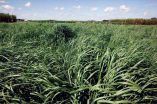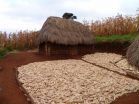(Press-News.org) March 9, 2015
PITTSBURGH--To fully understand how nanomaterials behave, one must also understand the atomic-scale deformation mechanisms that determine their structure and, therefore, their strength and function.
Researchers at the University of Pittsburgh, Drexel University, and Georgia Tech have engineered a new way to observe and study these mechanisms and, in doing so, have revealed an interesting phenomenon in a well-known material, tungsten. The group is the first to observe atomic-level deformation twinning in body-centered cubic (BCC) tungsten nanocrystals.
The team used a high-resolution transmission electron microscope (TEM) and sophisticated computer modeling to make the observation. This work, published in Nature Materials, represents a milestone in the in situ study of mechanical behaviors of nanomaterials.
Deformation twinning is a type of deformation that, in conjunction with dislocation slip, allows materials to permanently deform without breaking. In the process of twinning, the crystal reorients, which creates a region in the crystal that is a mirror image of the original crystal. Twinning has been observed in large-scale BCC metals and alloys during deformation. However, whether twinning occurs in BCC nanomaterials or not remained unknown.
"To gain a deep understanding of deformation in BCC nanomaterials," Scott X. Mao, the paper's senior author, said, "we combined atomic-scale imaging and simulations to show that twinning activities dominated for most loading conditions due to the lack of other shear deformation mechanisms in nanoscale BCC lattices."
The team chose tungsten as a typical BCC crystal. The most familiar application of tungsten is its use as filaments for light bulbs.
The observation of atomic-scale twinning was made inside a TEM. This kind of study had not been possible in the past due to difficulties in making BCC samples less than 100 nanometers in size as required by TEM imaging. Jiangwei Wang, a Pitt graduate student and lead author of the paper, developed a clever way of making the BCC tungsten nanowires. Under a TEM, Wang welded together two small pieces of individual nanoscale tungsten crystals to create a wire about 20 nanometers in diameter. This wire was durable enough to stretch and compress while Wang observed the twinning phenomenon in real time.
To better understand the phenomenon observed by Mao and Wang's team at Pitt, Christopher R. Weinberger, an assistant professor in Drexel's College of Engineering, developed computer models that show the mechanical behavior of the tungsten nanostructure--at the atomic level. His modeling allowed the team to see the physical factors at play during twinning. This information will help researchers theorize why it occurs in nanoscale tungsten and plot a course for examining this behavior in other BCC materials.
"We're trying to see if our atomistic-based model behaves in the same way as the tungsten sample used in the experiments, which can then help to explain the mechanisms that allow it to behave that way," Weinberger said. "Specifically, we'd like to explain why it exhibits this twinning ability as a nanostructure but not as a bulk metal."
In concert with Weinberger's modeling, Ting Zhu, an associate professor of mechanical engineering at Georgia Tech, worked with a graduate student, Zhi Zeng, to conduct advanced computer simulations using molecular dynamics to study deformation processes in 3-D.
Zhu's simulation revealed that tungsten's "smaller is stronger" behavior is not without drawbacks when it comes to applications.
"If you reduce the size to the nanometer scale, you can increase strength by several orders or magnitude," Zhu said. "But the price you pay is a dramatic decrease in the ductility.
We want to increase the strength without compromising the ductility in developing these nanostructured metals and alloys. To reach this objective, we need to understand the controlling deformation mechanisms."
The twinning mechanism, Mao added, contrasts with the conventional wisdom of dislocation nucleation-controlled plasticity in nanomaterials. The results should motivate further experimental and modeling investigation of deformation mechanisms in nanoscale metals and alloys, ultimately enabling the design of nanostructured materials to fully realize their latent mechanical strength.
"Our discovery of the twinning dominated deformation also opens up possibilities of enhancing ductility by engineering twin structures in nanoscale BCC crystals," Zhu said.
INFORMATION:
Contact: Joe Miksch, University of Pittsburgh News Services
[412-624-4356 (office); 412-997-0314 (cell); jmiksch@pitt.edu]
COLUMBUS, Ohio - Children whose parents think they're God's gift to the world do tend to outshine their peers - in narcissism.
In a study that aimed to find the origins of narcissism, researchers surveyed parents and their children four times over one-and-a-half years to see if they could identify which factors led children to have inflated views of themselves.
Results showed that parents who "overvalued" their children when the study began ended up with children who scored higher on tests of narcissism later on.
Overvalued children were described by their parents ...
A new study of Tourette syndrome (TS) led by researchers from UC San Francisco and Massachusetts General Hospital (MGH) has found that nearly 86 percent of patients who seek treatment for TS will be diagnosed with a second psychiatric disorder during their lifetimes, and that nearly 58 percent will receive two or more such diagnoses.
It has long been known that TS, which emerges in childhood and is characterized by troublesome motor and vocal tics, is often accompanied by other disorders, especially attention-deficit hyperactivity disorder (ADHD) and obsessive-compulsive ...
If advanced biofuels are to replace gasoline, diesel and jet fuel on a gallon-for-gallon basis at competitive pricing, we're going to need a new generation of fuel crops - plants designed specifically to serve as feedstocks for fuels. Researchers with the U.S. Department of Energy (DOE)'s Joint BioEnergy Institute (JBEI) have demonstrated the power of a new ally in this effort - proteomics!
In a study led by Benjamin Schwessinger, a grass geneticist with JBEI's Feedstocks Division, researchers used advanced proteomic techniques to identify 1,750 unique proteins in shoots ...
DURHAM, N.C. -- The discovery of the "exercise hormone" irisin three years ago and more than 170 related papers about it since have been called into question by recent research showing they were based on flawed testing kits.
Previous studies suggested that the hormone irisin -- named for the Greek messenger goddess Iris -- travels from muscle to fat tissue after exercise to tell fat cells to start burning energy instead of storing it. The finding ignited hope and press coverage that irisin could hold the key to fighting diabetes and obesity, perhaps one day taking the ...
In a study that helps to deconstruct how olfaction is encoded in the brain, neuroscientists at University of California, San Diego School of Medicine have identified a type of neuron that appears to help tune, amplify and dampen neuronal responses to chemosensory inputs from the nasal cavity.
The study, published March 9 in Nature Neuroscience, has applications to understanding the root cause of epileptic seizures, which are frequently centered in the olfactory cortex, the part of the brain that processes the sense of smell.
"Our sense of smell is complex and involves ...
A new class of drugs identified and validated by Mayo Clinic researchers along with collaborators at Scripps Research Institute and others, clearly reduces health problems in mice by limiting the effect of senescent cells -- cells that contribute to frailty and diseases associated with age. The researchers say this is a first step toward developing similar treatments for aging patients. Their findings appear today in the journal Aging Cell.
"If translatable to humans -- which makes sense as we were using human cells in many of the tests - this type of therapy could keep ...
Irvine, Calif., March 9, 2015 -- Long the stuff of science fiction, the disembodied "brain in a jar" is providing science fact for UC Irvine researchers, who by studying the whole brains of fruit flies are discovering the inner mechanisms of jet lag.
To do this, Todd C. Holmes, professor of physiology & biophysics in the UCI School of Medicine, and colleagues used imaging technology to make movies of fruit fly brains kept alive for six days in a petri dish. The scientists captured the activity of individual circadian clocks at single-cell resolution with an extremely ...
More than two years after Washington legalized marijuana, parents and teens may be hazy on the specifics of the law, if the findings of a new study are any indication.
University of Washington research, published recently in Substance Use & Misuse, found that only 57 percent of Washington parents surveyed knew the legal age for recreational marijuana use and just 63 percent knew that homegrown marijuana is illegal under the law.
And while 71 percent of 10th-graders correctly identified the legal age, fewer than half (49 percent) knew how much marijuana can legally ...
MISSOULA - Researchers at the University of Montana, Princeton University, Stanford University and Rutgers University, among others, are collecting new measurements of tropical forests to gain a better understanding of how they respond to seasonal climate variations.
The new information helps predict how the global tropics may react to future climate change. These findings are detailed in a paper titled "Photosynthetic seasonality of global tropical forests constrained by hydroclimate," which was published in Nature Geoscience this month.
"A better understanding ...
The relationship between human disease and environmental management has been the subject of extensive research, especially given the recent outbreaks of Ebola, SARS and other zoonotic infectious diseases that transmit from animals to humans.
The fieldwork of UC Santa Barbara community ecologist Hillary Young is a good example of researchers' continuing effort to understand exactly how environmental management affects disease emergence. In East Africa, Young examines the direct impacts of human disturbance on landscape and wildlife, as well as a variety of factors affecting ...

